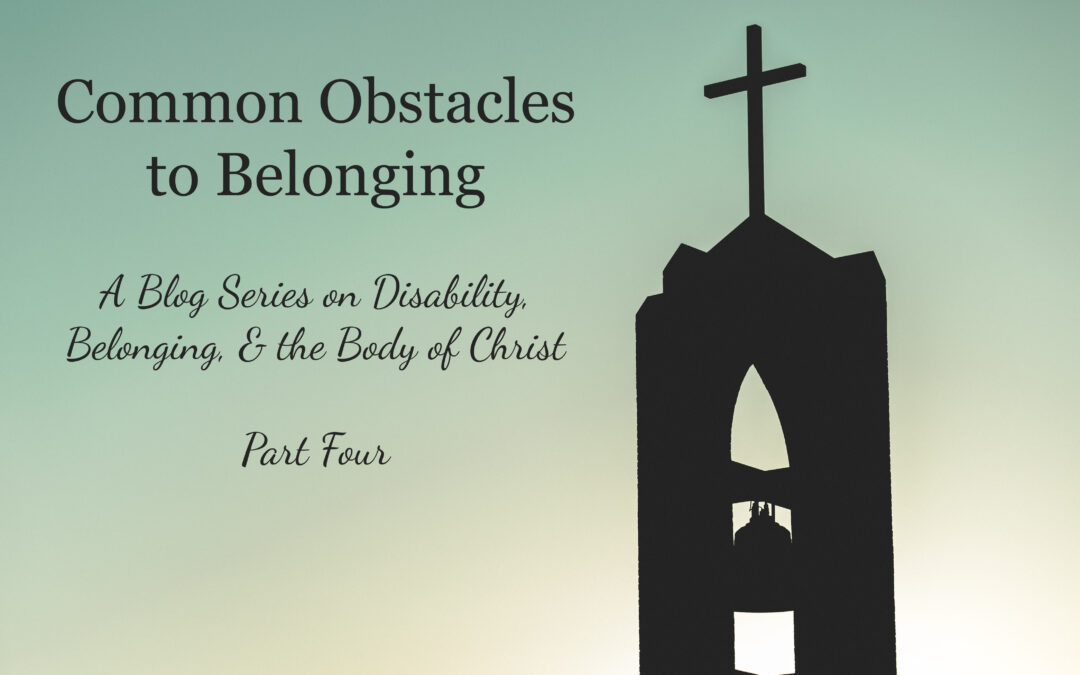“A history of exclusion or inhospitable attitudes can have a wounding effect on people with developmental disabilities and their families.”[1]
Erik Carter
A few weeks ago I interviewed a 24-year old young woman, who we will call Julie. She has lived with lupus for the past two and a half years. Since I carry the perspective of being physically disabled, I wanted to learn about life with an invisible disability. Julie felt like her church was responsive and caring in the beginning. The associate pastor visited the hospital. Other congregants asked how she was doing.
However, immediately following the diagnosis, Julie’s abilities were questioned. Who was she within the Church if she could no longer serve in the same capacity?
“Part of you that did exist doesn’t exist now,” she said.
She had a crisis of identity as her life changed and she dealt with the grief on her own. Over time, Julie confessed the attentiveness and care from the church dropped off.
“People can forget invisible disability,” she said.
After she shared that with me, I saw the same theme woven into my story. I’ve lived with Arthrogryposis from birth. I’ve also attended the same church from birth. You might expect me to have a strong sense of belonging, but the truth is it hasn’t always been easy.
Becoming an adult in the church of my childhood led to my own crisis related to disability questions I had not asked in my youth.
Three years ago I stepped away from my church to visit other congregations and figure out what was wrong. Why didn’t I feel like I belonged? Some of it was a normal part of growing up. Transitions happen. People move and move on. However, the bigger issue was feeling invisible and lost in the crowd at church.
Afterwards, I wrote a letter to my church and later shared it as a testimony moment. I wanted to bring awareness to the obstacles to belonging that I witnessed firsthand, and I wanted to publicly say to my community, “Thank you.”
Leaving for a time helped me understand I did belong. The following excerpt from the letter summarizes my exclusion experiences.
“Sometimes I was told exactly where the wheelchair seating was…In the very back corner…On an aisle off to the side. But it ended up being my bad side and I didn’t say a word… This made me feel excluded.
Sometimes there was a giant ramp up to the building, but no solution over a tall marble step. This made me feel frustrated.
Sometimes people didn’t greet me. They greeted my friend. This made me feel invisible.
Sometimes people turned their eyes away as they walked right by me. Why is a disability such a thing to fear? Does a wheelchair mean you can’t say a simple hello? This made me feel rejected.”
(Read the full letter at: https://lauracrobb.com/to-the-church-that-includes/)
The church of my childhood welcomed me back with hugs and “hey Laura“s. It isn’t perfect, and nowadays I feel less included due to the pandemic. Julie and I are two of many within the high-risk groups staying home so we can stay well while protecting those around us. Both of our stories represent some of the common obstacles to belonging.
- Access. It’s not just about the structure of the building. It’s about access to real community. We need relational access.
- Assumptions. As long as people are afraid of disability or uncomfortable with discomfort, congregations will struggle to build truly welcoming spaces. We need relational advocacy.
- Actions, or lack of. The church tends to reach out less when the disability or needs are ongoing, except when there is a “normal” family crisis, such as sickness, surgery, death, or a natural disaster. We need relational attention.
Access and actions shouldn’t focus only on meeting physical needs and ensuring physical presence. While those are important, people like Julie and myself want to know our absence is apparent, that we are missed, and you are still willing to show up.
Let us take to heart what my professor, Benjamin Conner, writes, “a full sense of belonging requires one’s being chosen.”[2]
Reflect on Your Own
In this season of social distance, how can you practice presence?
Refer to Scripture
Read Philippians 2:3-4.
Respond with Action
Show up. Stop by to say hi, even if it’s only 5 minutes. The presence of another is always a gift.
[1]Erik W. Carter, Including People with Disabilities in Faith Communities: A Guide for Service Providers, Families, and Congregations (Baltimore: Paul H. Brookes Publishing Co., 2007), 14.
[2]Benjamin T. Conner, Amplifying Our Witness: Giving Voice to Adolescents with Developmental Disabilities (Grand Rapids: William B. Eerdmans Publishing Company, 2012), 46.

